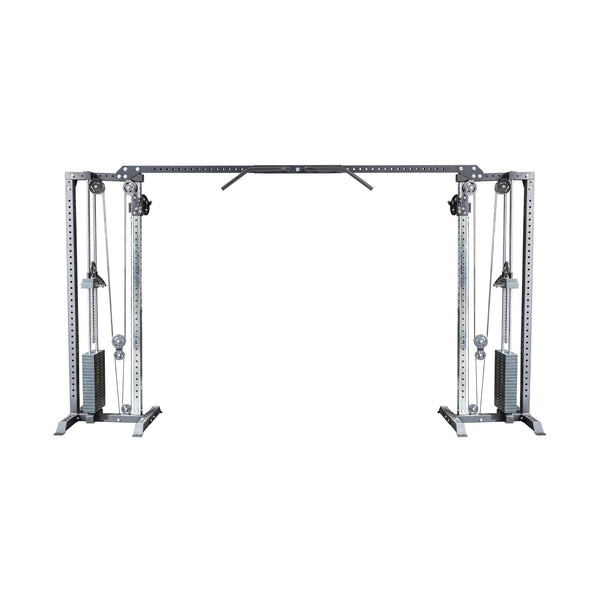So, you've set up your home gym and you're ready to get those pecs popping and delts dancing. Enter the cable crossover machine—your new best friend for sculpting a chest that even your reflection can't resist flexing at.
But what muscles do cable crossovers actually work? Let’s dive into the nitty-gritty and flex-plain everything you need to know.
The Muscles Engaged by Cable Crossovers
Cable crossovers are a powerhouse move that primarily target your chest muscles. However, they're not just a one-trick pony; they engage several muscle groups, giving you a well-rounded workout.
Primary Muscles Worked
The star of the show is the pectoralis major—the big, fan-shaped muscle covering much of your upper chest. This exercise is particularly effective in hitting both the upper and lower parts of your pecs, making it a go-to for comprehensive chest development.
The anterior deltoids (front shoulders) also play a significant supporting role. These muscles help you move your arms forward and together, adding to the effectiveness of the workout.
Secondary Muscles Worked
While your pecs and front delts are the main players, several secondary muscles get in on the action. The serratus anterior, located on the side of your rib cage, helps stabilize your shoulder blades, giving you a more controlled movement.
Your biceps brachii get a minor workout too, although they aren’t the primary focus.
Lastly, your core muscles are engaged to maintain stability and balance throughout the exercise. It’s like a full-body workout disguised as a chest exercise!
Pros and Cons of Cable Crossovers
Like any exercise, cable crossovers come with their own set of pros and cons. Understanding these can help you decide if this movement fits into your fitness routine.
Pros of Cable Crossovers
One of the biggest advantages of cable crossovers is their versatility. By adjusting the angle and height of the cables, you can target different parts of your chest, making this exercise adaptable to your specific needs.
The cables provide continuous tension throughout the movement, ensuring your muscles are working hard from start to finish. This continuous tension is something free weights can’t always offer. Plus, cable crossovers allow for a greater range of motion, giving you a deeper stretch and more effective muscle contraction.
Cons of Cable Crossovers
On the flip side, cable crossovers are equipment-intensive. You’ll need a cable crossover machine, which can take up significant space in your home gym.
Additionally, this exercise is very form dependent. Without proper form, you risk shoulder strain and might not target the chest muscles effectively. It’s essential to focus on technique to reap the full benefits and avoid injuries.
Other Exercises You Can Do with a Crossover Setup
A cable crossover machine isn’t just for chest exercises. This versatile piece of equipment can be used for a variety of other movements to target different muscle groups.
Tricep Pushdowns
Attach a straight bar or rope to the high pulley, stand facing the machine, and push down. This exercise isolates your triceps, helping you build strength and definition in your upper arms.
Face Pulls
Set the pulley at upper chest height, grab the rope attachment, and pull towards your face. Face pulls are excellent for targeting the rear delts and upper back, which can help balance out all the chest work you’re doing.
Cable Crunches
Attach a rope to the high pulley, kneel facing the machine, and crunch down, bringing your elbows to your knees. Cable crunches give your abs a killer workout, helping you build a strong, defined core.
Standing Cable Rows
Set the pulley at mid-height, grab the handle, and pull towards your torso. This exercise is fantastic for working your back muscles, improving your posture, and adding balance to your upper body workouts.
What Do Low Cable Crossovers Hit?
Low cable crossovers, where the pulleys are set at a low position, are particularly effective for targeting the upper part of your chest and the anterior deltoids.
By pulling the cables upward in a hugging motion, you emphasize the clavicular head of the pectoralis major. It’s like giving your upper chest a VIP workout session. This variation not only helps in building a well-rounded chest but also adds variety to your routine, keeping your muscles guessing and growing.
FAQs About Cable Crossovers
Q: Can I build a big chest with cable crossovers alone?
While cable crossovers are fantastic for shaping and defining your chest, incorporating other compound movements like bench presses and push-ups will help build overall mass. Think of cable crossovers as the icing on the cake, with compound exercises being the cake itself.
Q: How many sets and reps should I do?
Aim for 3-4 sets of 10-15 reps. Focus on a controlled movement and squeeze at the peak of each rep for maximum muscle engagement. Quality over quantity is key here.
Q: Are cable crossovers better than dumbbell flyes?
Both exercises have their benefits. Cable crossovers provide continuous tension and a greater range of motion, while dumbbell flyes can be great for building stabilizer muscles. Mix them up for the best results and to keep your workouts interesting.
Q: Can I do cable crossovers at home?
Absolutely! If you have a cable machine setup at home, you’re good to go. The Bells of Steel cable crossover is a great investment for any serious home gym enthusiast, offering durability and versatility.
Conclusion: Flex Those Pec-tacular Muscles!
Cable crossovers are an excellent addition to any home gym routine, offering versatility, continuous tension, and an impressive range of motion. By understanding what muscles they work and incorporating them into a balanced workout regimen, you’ll be well on your way to a chest that commands attention. Don’t forget to explore other exercises with your crossover setup and keep challenging those muscles.
So gear up, get those cables in motion, and let’s make those pecs pop and delts dance!




